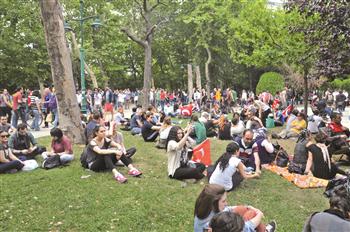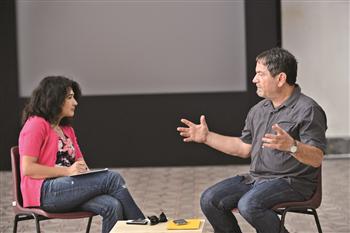Occupy Taksim: The Struggle Is Ideological
By Countercurrents.org
03 June, 2013
Countercurrents.org

Demonstrators in Gezi Park , next to Taksim Square . DAILY NEWS photo, Hasan ALTINISIK
The Occupy Taksim protests were given impetus by the Islamist Justice and Development Party's (AKP) with its conservative agenda.
Cihan Çelik in an article in Hürriyet Daily News [1] said:
Waking up to a morning that lost its freshness to a bitter air filled with tear gas, the mood in Cihangir, a district close to Istanbul's iconic Taksim Square witnessing a popular unrest against the controversial urbanization project in the city, was replaced by deep silence after a night of clashes and rallies.
This was the early Saturday morning atmosphere in the heart of Istanbul and the beginning of a day that will witness historic moments with ten thousands of Occupy Taksim protesters.
He said:
Friday night was also historic for Istanbul as well as Turkey since the city has been always dominant for the entire country with different reasons and sentiment but Saturday has witnessed a rare moment for Turkey , which has not seen any popular unrest since 1980s – a period that ended with a military junta.
The article continued with a sub-heading “The history of metamorphosis”:
The metamorphosis of the Occupy Taksim protests has been giving signals in the recent months with the ruling Justice and Development Party (AKP) staging political campaigns with its conservative agenda on different colors of Turkey. Taksim was a symbolic venue of the silent quarrel with its traditional meaning of being both the city's political and cultural centers as well other attractions irking the conservative values.
The passive aggression on the district started with the so-called “table operations” nearly two years ago and the symbolic tiny streets were “cleared off” from tables serving alcohol. Then, it was put under a blockade with an urban project making its facet what it was years ago. While the AKP leveled up its campaign with its recent war on the alcohol, like many others in the rest of the country, Istanbul 's locals felt threatened by an attack on a lifestyle different than what the government wished them to have. This was a reminder of feeling when the AKP first came to power nearly a decade ago but now it was not only the old Republican “guards” of Turkey that was troubled by the actions of the authorities.
The growing discontent was the boost for the core Occupy Taksim protesters waiting for more hands in the middle of Istiklal on Saturday morning.
The protests united people with different motivations, ethnic backgrounds, political identity and religious beliefs. Perhaps, at odds hands during daily life have been given to each other when they came under heavy police attack while still mocking them with slogans like, “Give us more tear gas.” Having similar characteristic of the so-called “Arab Spring” with its leaderless trait, the Occupy Taksim protests turned into a political challenge to the AKP government that has been missing in the Turkish politics for years. It would have more echoes and appeared bearing first fruits with the senior Turkish officials signaling a U-turn over the controversial Taksim project.
Cihan Çelik concludes his article:
Despite the high decibel and defiance, it would be still a too early call to make comparisons between the Occupy Taksimers and Arab Spring protesters while the labels, such as “Turkish Spring,” are also unripe for now. That being said, what protests showed to both the country and its rulers was that the popular voice shall still linger over their authority despite being to-weak-to-be-heard for long.
Ideological struggle
In an interview with Hürriyet Daily News, Korhan Gümüs, teacher of “urban management and practices” at Mimar Sinan University , said:
“Taksim is a site of struggle for ideological predominance.”
Gümüs has a weekly program called "Metropolitika" on civil and local participation, broadcast on Açik Radyo (Open Radio). He worked as the director of Local Authorities Research Department at Istanbul Bilgi University , and was the driving force behind various civil initiatives. Gümüs is also a writer for Architectural Review XXI, and his articles have been published in several newspapers.
Taksim Square acquired a political identity after the founders of the republic saw and designed it as their prestige project, according to architect Korhan Gümüs. Ever since, the square has become a site of struggle for dominance, with each government trying to leave their mark, says Gümüs
The interview was taken by Barçin Yinanç.

‘Instead of starting with construction, we need to first discuss ideas,' says Korhan Gümüs. DAILY NEWS photos, Emrah GÜREL
After the Republic designed Taksim Square as its prestige project, the area became a ground for tension about who was going to dominate the public space, according to architect Korhan Gümüs.
Each government has sought to leave its mark on the square, and the ruling Justice and Development Party is no exception to this rule, said Gümüs, a member of the civil initiative Taksim Platform that is opposed to the government's plans to redesign the square.
The government is displaying the same unilateralism that was seen during the one-party regime in the early days of the Republic, Gümüs told.
Following is the interview:
Q: What's the significance of Taksim for Istanbul ?
A: Taksim is a public square that came into being later, during the republican era. Istanbul was forgotten for 13 years, until 1936. Then the republic started to see Taksim as a space to mark its [existence]. It constructed a recreation and cultural space. The method at that time was to bring over a foreign expert. The Frenchman Henry Proust was called for a long-term program. The Republic viewed Taksim Square as a prestige project. The square was expanded, and for this, the Topçu Artillery Barracks, which had not been used since World War I, were demolished. The city acquired a green space and the city's most important public cultural establishments were constructed. These establishments were administered by civil servants, but by the 1950s, a problem of governance started to surface. There was a management vacuum. Privatizations started; hotels were constructed. In the world, there are different management models to maintain public spaces. Unfortunately; the model that was endorsed from the beginning that is not participatory has continued throughout the years.
So there is a need to redesign Taksim Square ?
Of course there is a crisis there; a vacuum. But there is the problem of sacred baggage that covers that vacuum. This is a stage for [social] design; there is a struggle for predominance.
The square gained a political identity then?
With the intervention of the Republic, it gained a political identity and became sort of a fighting ground for the nation-state. Successive governments became uneasy by the fact that it has been used for May Day demonstrations.
Can you elaborate what you mean with sacred baggage?
The square became a space of tension about who is going to dominate the public space. This situation peaked, for instance, during the Feb. 28 process when there was tremendous controversy over claims that Prime Minister Erdogan, who used to be the mayor of Istanbul at that time, was planning to construct a mosque there. Each government has tried to leave its mark to the square.
So it never became a matter of urban planning, but rather an ideological symbol.
Each government thought they knew better what is good for the people. Each party that came to power said: I am elected and since the people support me; I can do whatever I want.
But at the end of the day no one has succeeded in redesigning Taksim.
Because the model endorsed until now contains a crisis. A different model was never endorsed.
The prime minister did not use this occasion; instead, he acted with a trauma which dates back to Feb. 28 [when he was sentenced to prison time]. He decided to intervene in the square without constructing a mosque. So the project of constructing a mosque was transferred to Çamlica, a much more attractive place. And he continued this old model that creates tension.
The artillery barracks were demolished during the one-party regime. He no longer sees that space as a green space. The mentality is; “we need to compensate; how? By rebuilding the barracks.” But at the end of the day, who is going to manage it? It cannot be used as a barracks, so it will be either a shopping mall or a residence. He later confessed that it would be a shopping mall.
So on the one hand, there is ideology, and on the other, there is total surrender to market relations. Nothing is left in Taksim in the hands of the public. The congress center is being managed by a private hotel.
The problem of Istanbul is that there is no public program to support intellectual production. All the cultural activities in Istanbul , like the biennial, et cetera, have no public support. Contemporary art, architecture and even archaeology have become an issue for philanthropists. The public sector functions with bids. Bids mean engineers. Procurement bids are a way of arranging the relationship between the market actors and the government. It never endorses intellectual creativity. You can make an archaeological excavation by bids. You first generate ideas; then the engineers and constructors become part of the project. In Turkey , the reverse is valid; as we have seen in the Taksim project; the public sector makes a deal with a private company, orients them the way it wants, and we start discussing it after the construction starts. All these projects are a product of a market mentality.
Now that we have an ongoing project, what are the objections of the opponents?
The problem is that the opponents act with the same mentality of this sacred baggage. They say, “You can't touch it.” One side says, “I will tear it down, I have the support of the people, you can't prevent me;” the other side says: “No, you can't.” This sort of confrontation paralyzes creative thinking.
So each side has a dogmatic approach.
It is normal for civil society to be dogmatic. Some may want a mosque on Taksim Square , others may want to have a May Day celebration; all these views are valuable; But the public is different; it can't say, “I will impose my values in an authoritarian way on others.” So the public model needs to be updated. Instead of starting with construction, we need to first discuss ideas. We need a model that can use the energy of civil society that can work with NGOs – a multi layer model.
The prime minister repeats the same mistakes. He started to make mistakes which should not be done by a wise politician.
Why do you say so?
He perceives everyone opposing his projects as a handful of marginals. But it is becoming clear this is not the case.
But maybe his project might end up being a very good one; maybe everybody will like it.
We can't know that. Our job is to discuss it in advance. The moment the prime minister constructs the artillery barracks, he would end up doing exactly the same thing as the mentality that demolished these barracks. I am against this type of unilateralism.
The Taksim project was known a long time ago. Why and how do you think these protests flared up all of a sudden?
Actually, some were keeping guard there already. Of course, I'd like to thank the prime minister for mobilizing the opposition by his stance. Due to his reaction, this has become larger than the opposition of a handful of activists.
Source:
[2] Hürriyet Daily News, 'Taksim is a site of struggle for ideological predominance'
Comments are moderated


